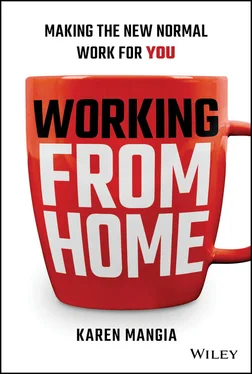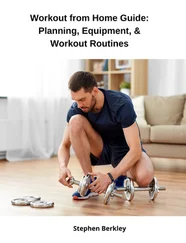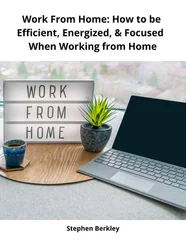Whatever you choose, choose comfort . A comfort that inspires you – not one that shows what you slept in last night.
Because you can't be at your best working in your jammies.
Arianna Huffington ( https://bit.ly/wfh-arianna1) explains why:
“I fainted from sleep deprivation and exhaustion,” she shares in her book, Thrive (Harmony, 2014). The incident left her with a broken cheekbone and provided a painful inspiration for her next book, Sleep Revolution (Harmony, 2016). In it, Arianna asks us to rethink rest – a subject I wrote about in my first book, Success With Less . It's vital that we take a pause – a break – in order to see things in a new way. That powerful pause is vital when you're shifting from your home life to your work life. There's a shift, but your location doesn't change. If you're wearing to work what you wore to bed, you're missing a powerful pause. And a critical mindset shift for your success.
Arianna says that having specific clothes for a specific task is critical. Find something that you can wear when you sleep and only when you sleep, she says, because it's a crucial distinction that our brains need. In a COVID‐19 world where boundaries have been blurred, setting up the right context is crucial.
“Something switches in our brains when we put pajamas on,” Arianna shares, describing the cues and clues that our bodies need in order to slow down. “On my nightstand is a pile of books that have absolutely nothing to do with work. They're novels, poetry, and books about spirituality.” She doesn't drink caffeine after 2 p.m., and finishes her day by writing down three things she's thankful for, in a gratitude journal. Again, the distinction between waking and sleeping is a model of best practices when working from home. “Slipping on sleepwear is a signal to our bodies: time to shut down.” What signals are you sending to your body when it's time to get to work? And when it's time to step away? Strategically, clothing choices can separate one function from another – even when those functions occur in basically the same space.
Your office environment is where you will spend some serious time. Shifting into an environment that serves you best is a small price to pay when it comes to your career. Virginia Woolf was right: a room of one's own is ideal for your creative pursuits. But what if you find yourself in a small space?
Marisol is laughing at that question. She always looks fantastic on video – I've been a guest on her global Zoom sessions for the pharma company where she works. Basically, she's broadcasting at TV‐station quality with impeccable form and professionalism – but she's not in a studio.
In a private video call, she's acting like she's got a secret – and I'm wondering if she's ever going to stop giggling. I had simply asked her to pan to her right and left, because I was curious about what her home office space looked like. “You know what?” Marisol asks me, “you would find that I am literally in the corner of my bedroom,” she says, lifting her laptop and panning to the left to show that she is quite correct. Her broadcast booth is wedged into a corner. Beside her are some toys on the floor next to an overflowing laundry basket and what looks like a half‐finished school project – something to do with lava, I'm guessing, from the mountainous shape and colors. In other words, her place probably looks a lot like yours – but she's dedicated a small area inside of it to creating big results.
“I hadn't noticed it before,” Marisol says, swinging the camera back to its original position, “but when I take my laptop here and there and everywhere in my house, I suddenly make every place my workspace. When I spread work out all over,” she says, catching her breath, “I can't go anywhere to get away from work. There's no delineation – no boundary.” That kind of work situation – where work is anywhere, everywhere, and always on – is a real turn‐off for office success.
Surround Yourself with Success
When you see me on a Zoom call, you'll notice that a black‐and‐white photo hangs inside a simple black frame on the wall behind me. It's a picture of Maxwell Street in Chicago circa 1938 – a reminder of a special time, of someone who was very special to me.
As a little girl, I sat at the feet of my grandmother, listening to her tales of the magical market that lit up the short three blocks known as Maxwell Street – a place of wonder and fascination from her childhood to mine. What do you have around you that reminds you of who you are? Of where you've come from? Of the people who've gone before so that you can be who you are?
Hang pictures that inspire you. Mementos. Artifacts. Small items no bigger than a shot glass or ones that are as big as a motorcycle – whatever it is that feeds your soul and fits into your space. Place items nearby that remind you of what you've done – or to spark what you're going to do. We all stand on the shoulders of so many who have paved the way before. Who are those people, for you? In your home office, your choices are truly your own. The history, hopes, and dreams of my family and friends are a source of inspiration and comfort on every kind of day.
On my desk, in front of me, I see the box of cards from my three goddaughters. They wanted to inspire me while I was writing this book, so they sat down and wrote about 50 handwritten notes. (You'll have to check out my next book, Listen Up! [Wiley, 2020], if you want to meet the most amazing three girls on the entire planet, https://tinyurl.com/wfh-listenup. But I digress.)
When I'm feeling a little low, or a little quarantined (are you with me?), I reach into the box for a fistful of encouragement. I just pulled one out. The envelope is addressed to me, so it's like a miniature present with my name written under a big red heart. Like all of the cards, it's unsealed for easy access. This note happens to be from Lorelei (she won the Most Likely to Become a Leader award, at her virtual sixth grade graduation): “Don't give up!” it says, in multi colored markers, with a revised “e” next to a big exclamation point. She's not afraid to be bold. I like her style. “I am very proud of you and proud that I know you. So don't lose hope. – Lorelei”
How awesome is that? I'm lucky to have an entire box of inspiration right here on my desktop. Hope by the handful. How about you? What picks you up when the workday gets you down?
What is in your field of view, right now, that encourages you? What reminds you of who you are – and pushes you toward who you are yet to be? Surround yourself with the mementos and reminders that reflect your heart, so that your mind can function more effectively.
Building Blocks: Making Your Space Productive
More specifically, here are some clear‐cut do's and don'ts, designed around a home office environment where video calls are part of your daily bread:
DO: Look here. Figure out a way to raise the camera on your laptop up to the level of your eyes. A shoebox or even a stack of books can help. From a nonverbal standpoint, we use eye contact to convey warmth, connection, and trust. How can you send that message without looking into the camera? Remember the old‐school networking strategy: “Look 'em in the eye.” The camera is where your audience is – keeping the camera at eye level will help your impact on every possible level.
DON'T: Have a stare‐down contest. If you leave your laptop in your lap, or stare down at it on the table, you'll be broadcasting like Nostrildamus. I'm not talking about the sixteenth‐century futurist and author of Les Prophéties (the prophecies). His name was Nostradamus. I'm talking about a twenty‐first‐century goofball, broadcasting nothing but nostrils to the boss and co‐workers. I predict that nobody wants to see that. You don't have to be a prophet to know that a nose cameo could limit your future prospects at the company.
Читать дальше












